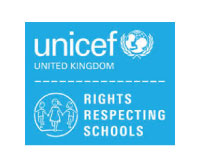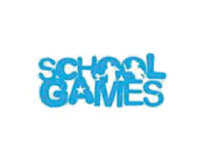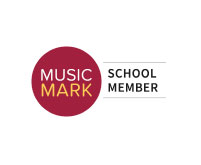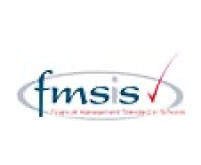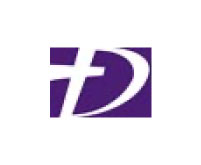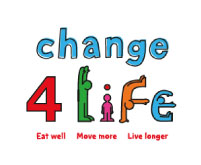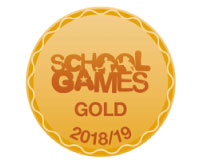Immersive Reading at Egglescliffe
At Egglescliffe CE Primary School, we aim to develop an enthusiasm for literacy in all its forms and for children to develop the confidence to express themselves both orally and through the written word.
Reading is at the heart of the curriculum. Teaching a child to read is the greatest gift that we can give a child in our school. Because of this, we see it as a primary purpose of our curriculum. From Early Years to Year 6, we ensure that our children not only learn the skills and knowledge to enable them to read, but also to promote positive life-long attitudes towards reading – that will take our children through secondary school and into adulthood.
Teaching children to ‘decode’ or read in its most basic form is a key driver for our Early Years and Key Stage 1 curriculum. Once children can read, through a robust and systematic approach, the world opens up to them. It is our duty to ensure that our children are ready to embrace both literary and wider world. These skills will enable children to access all aspects of the curriculum.
Research shows that approximately 90% of the vocabulary that we meet is only ever met through reading. Reading high quality texts, coupled with an interesting and knowledge rich wider curriculum is key to securing our children’s confidence and mastery of the English language.
By developing a comprehensive range of reading skills, we aim to foster in the children a love and appreciation of a variety of literature with the overarching aim for children to be able to read with fluency, accuracy, understanding and enjoyment.
We are determined that pupils learn to read easily, fluently and with understanding, through the daily rigorous teaching of synthetic phonics in Reception and Key Stage One.
Direct phonics is started within the first few weeks of children starting school; no time is wasted. The phonics teaching is intensive, following the Pearson’s ‘Bug Club’ programme.
As children become more confident readers, carefully chosen books also include the common exception words which children have been taught within the phonic scheme.
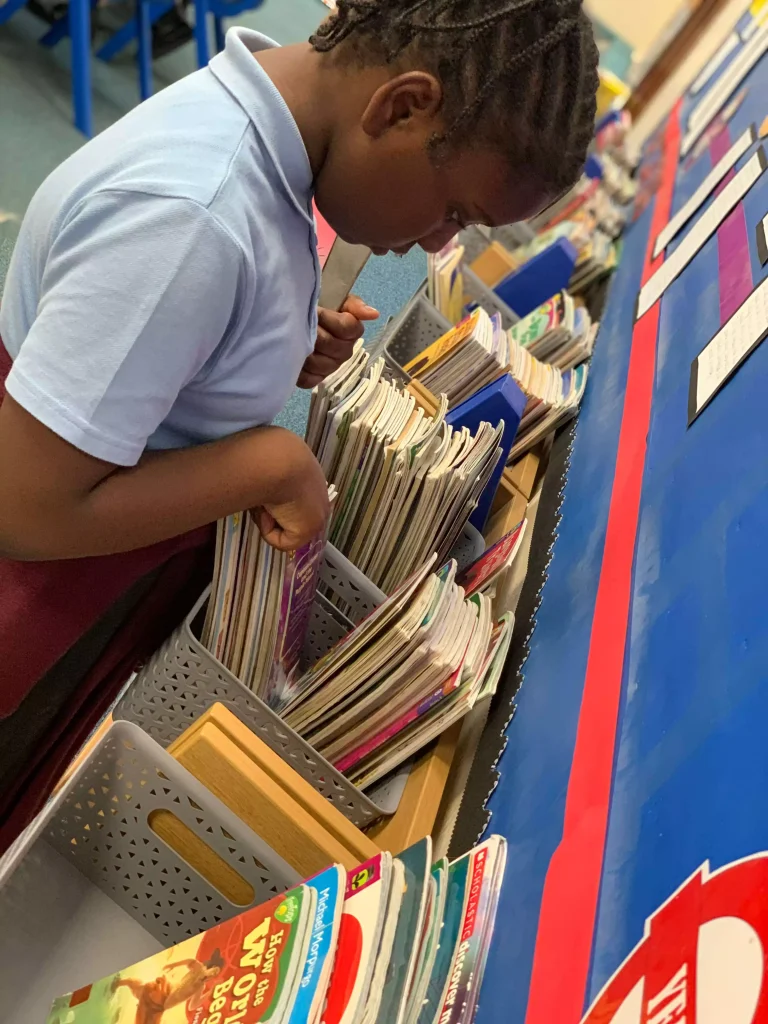
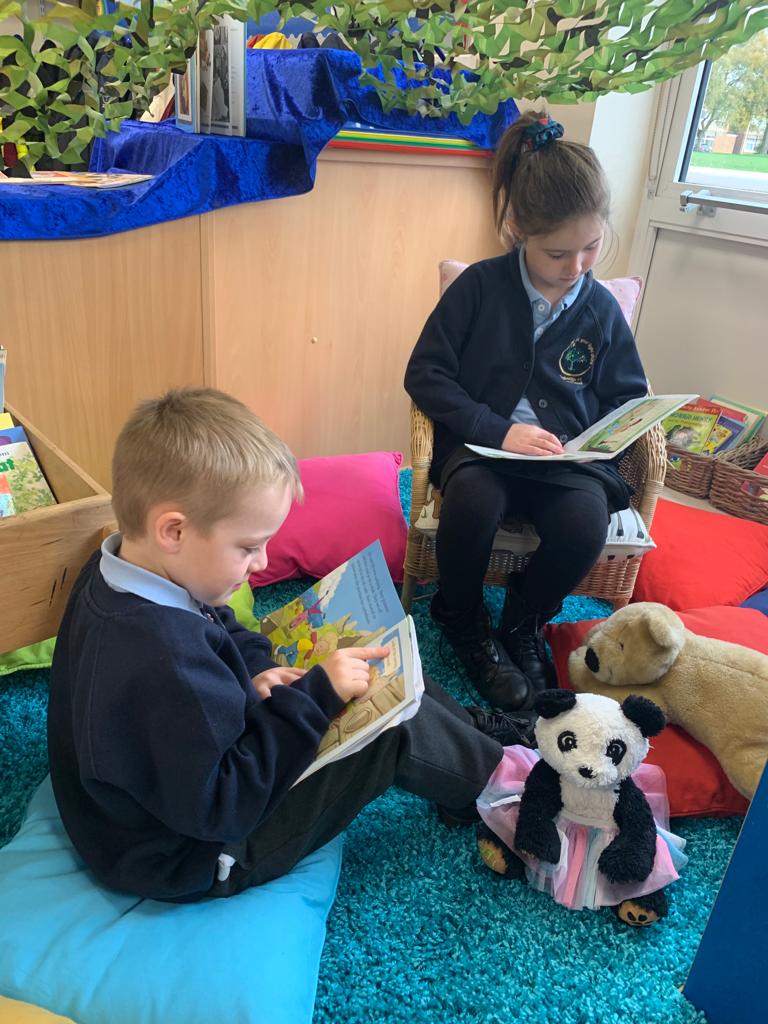
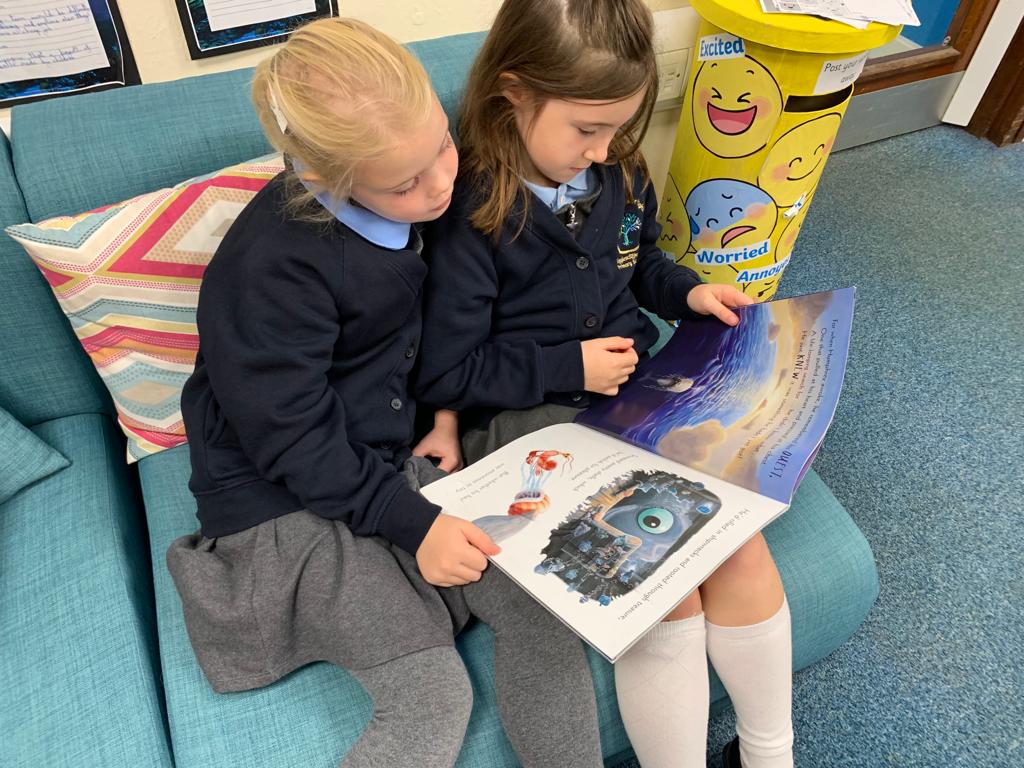
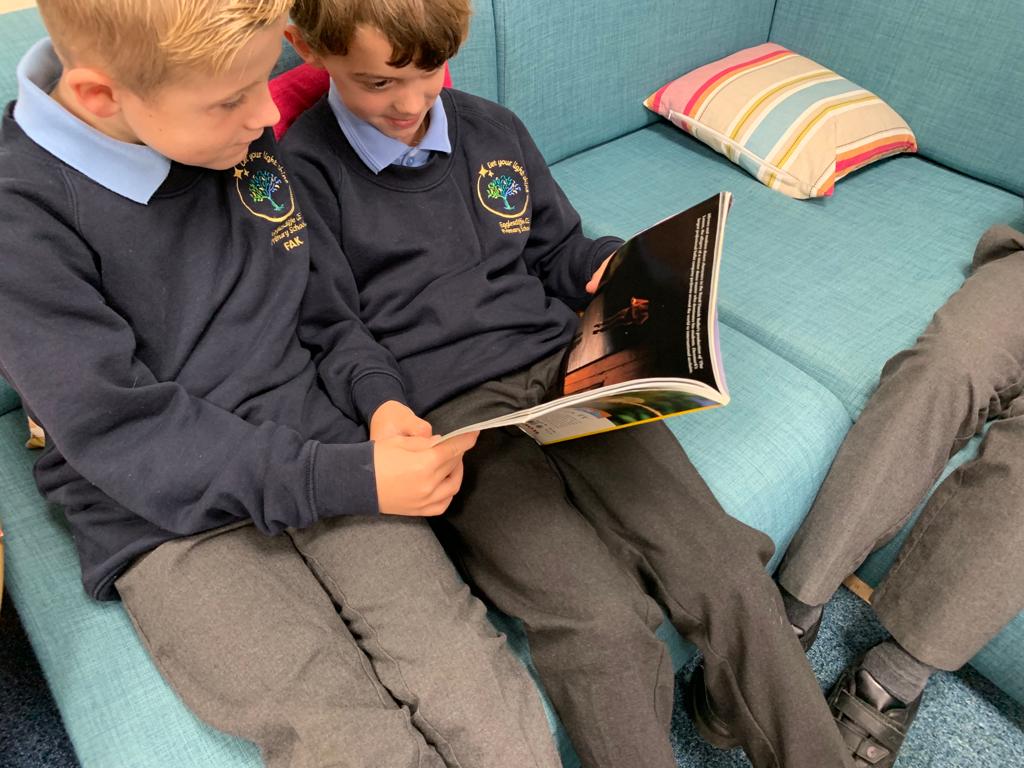
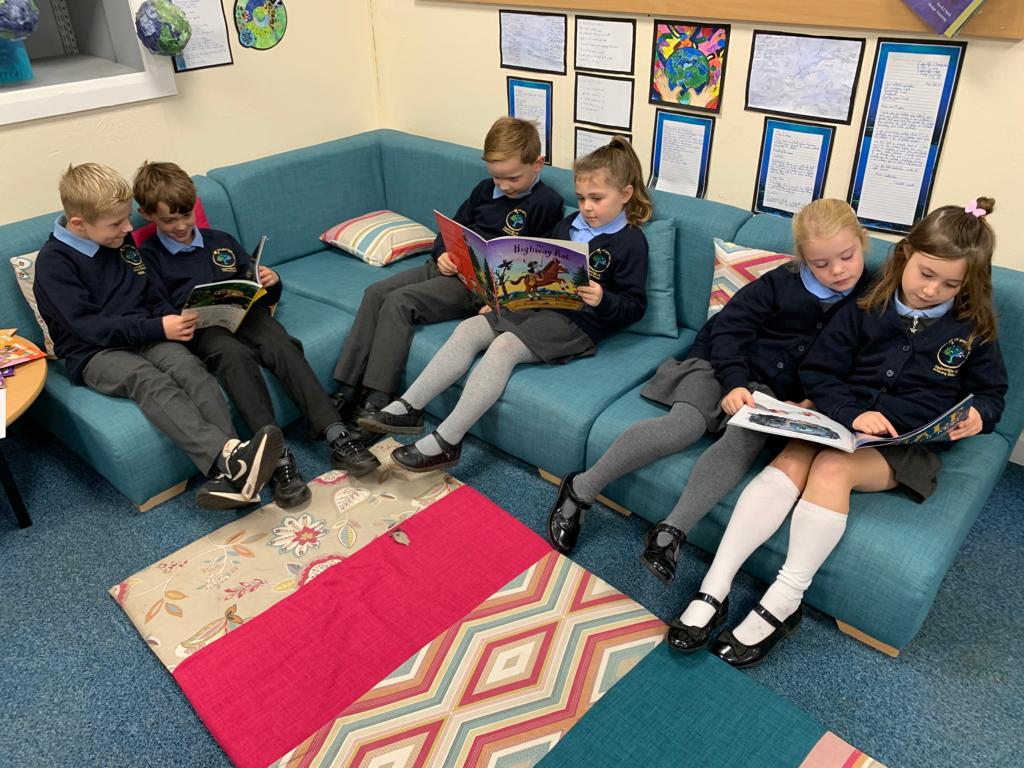
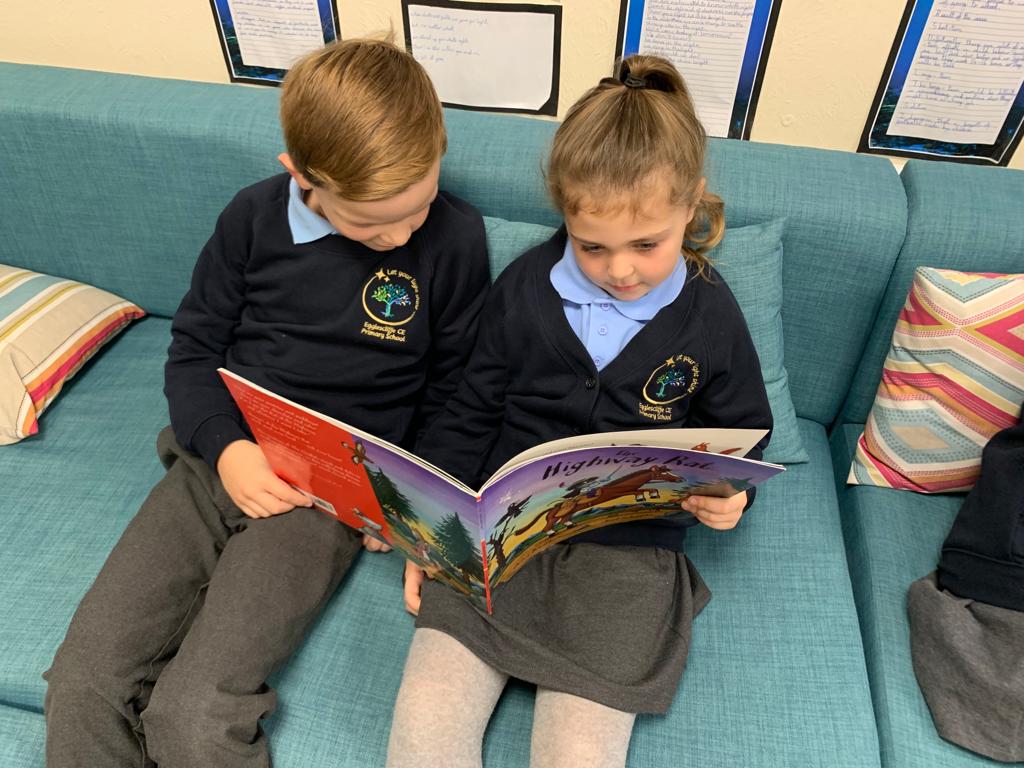
Phonics Teaching Approach
The teaching of phonics in school is systematic and expectations are clear. Of the 26 letters and 44 phonemes, there are approximately 140 different letter combinations, which children need to learn to become fluent readers.
Home phonic reading books (Phonics Bug) align with the child’s phonic phase. Children’s phonic reading ability is linked to children’s spelling abilities. Children apply their learnt sound on the day they are exposed to it. This is closely linked to the explicit teaching of letter formation.
Phonics teaching includes common exception words and most are phonetically irregular, so are best taught as ‘sight words’ – where children just ‘know’ the words without using phonic blending strategies.
Phonics Year Group Expectations
Reception
The end of year expectations for children’s phonics ability is to be secure in Phase 3 with children accessing Phase 4 upon exiting Reception. Staff embed opportunities to play with and explore sound, and equip children with core listening and sound discrimination skills, which are required for success in reading and writing as the children grow. Children who are not secure in phase 1, will be supported in this phase alongside the teaching of phase two.
| The children will be able to use, understand and demonstrate the following terms: phonemes | The smallest unit of sound you can hear within a word. There are 44 phonemes in the English language |
| grapheme | The symbol of a phoneme. A letter or group of letters representing a sound |
| digraph | 2 letters that make one sound (phoneme) e.g. sh/ai/ew |
| trigraph | 3 letters that make one sound (phoneme) e.g. tch/igh |
| CVC words | A word containing the sequence consonant, vowel, consonant e.g. p-i-n/ ch-a-t as the ‘ch’ grapheme works together to make a single sound |
| split vowel digraphs | A digraph split by a consonant e.g o – e The split digraph in hope creates and ‘long o’ sound. |
| blending | The merging together of the separate sounds |
| segmenting | Breaking words down into phonemes to spell in a word. |
| decode | To read words |
| encode | To spell words |
| Capital letter and lower case letter | |
| Tricky words | Words like they and said which can’t be sounded out easily. |
Year 1
Children are expected to begin Year 1 at Phase 4 with an end of year aspiration of completion of Phase 5. Phase 6 is also commenced (the prefix ‘un’ and simple unchanged suffixes such as ‘ed’) in accordance with our reading and writing objectives. At the end of Year 1, all children are given a Phonics Screening Check to ensure they have mastered the appropriate knowledge.
Year 2
Expectations are for children to enter secure at Phase 5, with an end of year expectation and completion of Phase 6. Due to the variety of rules and alternatives, time is spent deepening and ensuring a strong understanding of these phases. Spelling also links to phonics which falls in the Phase 6 category (i.e. prefixes and suffixes.)
Progression in Fluency
In order to become fluent readers, children must master the appropriate phonic sounds detailed in the phonics overview. However, in order to continue to develop as fluid readers, the following progression from the National Curriculum is followed:
| Reception* | Year 1* | Year 2* |
• Children read and understand simple sentences. | • Apply phonic knowledge to decode words | • Secure phonic decoding until reading is fluent |
| • They use phonic knowledge to decode regular words and read them aloud accurately. • They also read some common irregular words. • They demonstrate an understanding when talking with others about what they have read. | • Speedily read all 40+ letters/groups for 40+ phonemes • Read accurately by blending taught GPC • Read common exception words • Read common suffixes (-s, -es, -ing, -ed, etc.) • Read multisyllable words containing taught GPCs • Read contractions and understanding use of apostrophe • Read aloud phonically-decodable texts | • Read accurately by blending, including alternative sounds for graphemes • Read multi-syllable words containing these graphemes • Read common suffixes • Read exception words, noting unusual correspondences • Read most words quickly & accurately without overt sounding and blending |
| Year 3 / 4 | Year 5 /6 | By Key Stage 2, children should be able to decode accurately, and be applying a growing wider English curriculum knowledge to their reading of new and challenging vocabulary – progressively with the increasing level of challenge presented in the texts, which they are presented. |
• Apply their growing knowledge of root words, prefixes and suffixes, both to read aloud and to understand the meaning of new words they meet • Read further exception words, noting the unusual correspondences between spelling and sound, and where these occur in the word | • Apply their growing knowledge of root words, prefixes and suffixes (morphology and etymology), both to read aloud and to understand the meaning of new words that they meet |
For children who did not pass the Phonic Screening Check in Year 1, or Year 2, it is vital that intensive decoding work continues. Children who commence Key Stage 2 unable to meet the demands of the Phonic Screening Check, cannot access age appropriate text within the English and wider curriculum and this must be catered for appropriately across the full curriculum alongside intensive intervention.
A Wider Reading Approach:
We understand that reading is a developmental process and part of life-long learning. Therefore, there is an expectation that every new English unit begins with a quality text, which challenges pupils, including the more able. By developing a comprehensive range of reading skills, we aim to foster in the children a love and appreciation of a wide range of literature, including that from our literary heritage.
Each term, the children will enjoy ‘Share One Book’. This is a wonderful opportunity for the whole school to come together with a love of reading. We hope you will enjoy looking on DB Primary at some of the amazing work that stems from reading ‘a good book’.
Reading for Pleasure
Reading for pleasure opens up new worlds for children. It gives them the opportunity to use their imagination to explore new ideas, visit new places and meet new characters. Reading for pleasure also improves children’s well-being and empathy. It helps them to understand their own identity, and gives them an insight into the world and the views of others. Research shows that reading for pleasure can be directly linked to children’s success throughout their time at school and even into adulthood.
This language focus starts in Early Years. The promise to our youngest children is that they will experience at range of rich experiences every day: stories, non-fiction books, rhymes, songs, poems etc. Across the reception year, children have homework of reading their books, accessing their e-books and learning nursery rhymes at home, by heart. This develops children’s understanding of rhyme, intonation, performance and vocabulary knowledge, with increasing complexity across the year.
We actively promote reading for pleasure through access to high quality materials; appropriate reading challenge; reading across the curriculum and the daily, ‘Drop Everything and Read’. We recognise the value of the class reading together, experiencing the joy and emotions of a good book together. Staff read to children of all ages daily, sharing a passion and skill in reading aloud to children.
Reading quality literature is the central driver for our English curriculum; children’s writing, discussion and skills work (e.g. grammar) will all stem from a ‘good book’. We recognise that reaching the ‘Expected Standard’ in Year 2 or Year 6 doesn’t make children a ‘good reader’ by default – but our curriculum aims to deepen children’s love of reading through this immersion within the best children’s literature available – not only to develop children’s reading and vocabulary skills, but also their appreciation and value of books, authors and reading.
Reading, of course, is not limited to dedicated reading lessons. At Egglescliffe CE Primary School, children read across the curriculum every day, embedding and practising the reading skills and knowledge taught.
Whole Class Reading VIPERS
Children are explicitly taught the skills of reading (outlined in the National Curriculum and the KS1 and KS2 test domains) through the use of VIPERS which were created by Rob Smith (The Literacy Shed).
The Reading Vipers can be used by both KS1 and KS2 with a little adaption. The main difference being in the S.
Sequence – KS1
Summarise – KS2
In KS1, ‘Explain’; is not one of the content domains, rather it asks children why they have come to a certain conclusion, to explain their preferences, thoughts and opinions about a text.
What are VIPERS?
VIPERS is an anagram to aid the recall of the 6 reading domains as part of the UK’s reading curriculum. They are the key areas which we feel children need to know and understand in order to improve their comprehension of texts.
VIPERS Stand for:

The 6 domains focus on the comprehension aspect of reading and not the mechanics: decoding, fluency, prosody etc. As such, VIPERS is not a reading scheme but rather a method of ensuring that teachers ask, and students are familiar with, a range of questions. They allow the teacher to track the type of questions asked and the children’s responses to these which allows for targeted questioning afterwards.
Key Stage 1
In Key Stage One, children reading skills are taught and practised using the VIPERS during whole class reading sessions. These are also taught during precision guided reading sessions. Guided reading sessions are based on children’s needs as highlighted in ongoing assessments and focus on the two dimensions: reading to learn and learning to read.
Question stems can be found here:
KS1 Reading Vipers (literacyshedblog.com)

Key Stage 2
In Key Stage Two children reading skills are taught and practised using VIPERS during whole class reading sessions.
Question stems can be found here:
KS2 Reading Vipers (literacyshedblog.com)

Whole Class Reading Lesson Structure in KS2.
The class teacher models reading, paying close attention to punctuation and intonation. Sometimes, the teacher will read aloud whilst pupils track the text. Other times, pupils will read aloud together as a class or individually. This gives the class teacher an opportunity to assess fluency and accuracy when reading.
We prepare them for reading:
- Orientation: Consideration to what needs to be put in place for children to access the text:
- Activation of prior knowledge: Helping children make connections between their own experiences and a text is a useful way into a new text, particularly if the context is unfamiliar and the connections are not immediately apparent. This part of the process is important to gauge children’s prior knowledge. It is also an opportunity for children to share different cultural experiences and learn from each other.
- Building background knowledge: In some instances, it is beneficial to develop background knowledge prior to reading. Consider the context, the children’s experiences and the assumptions about prior knowledge assumed by the text e.g a topic link. A judgement has to be made about what to teach in advance, and what is best left to emerge through the course of reading.
Active Reading:
If you know that there is a funny/scary/interesting bit in the text that you are about to read with the class, prepare them for it. Following the read, praise the children who reacted so they know that this is how you would like them to engage with a text.
To promote active readers, nurture ‘in the moment’ reading. This could simple as the teacher reading the text to the children, and then returning to the beginning and re-reading, but this time pausing to share reading reactions as they occur.
Listen to children think whilst reading! When working with a child one to one, or in a small group, invite them to read, but let them know that you will be interested in their thoughts as they read. Invite them to pause when they come across anything of interest/concern/alarm etc and tell you about it.
We promote engaged readers; children who read like nobody is watching!



